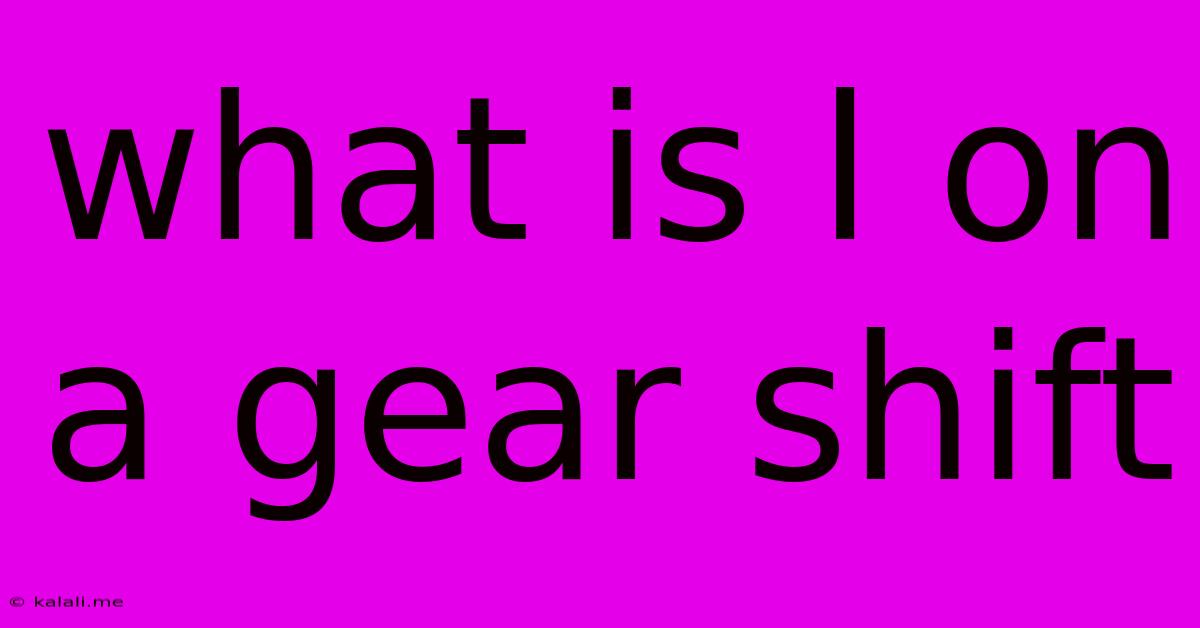What Is L On A Gear Shift
Kalali
Jun 04, 2025 · 3 min read

Table of Contents
What is "L" on a Gear Shift? Understanding Your Car's Low Gear
So, you've spotted an "L" on your car's gear shift, but you're not entirely sure what it means? Don't worry, you're not alone! Many drivers are unfamiliar with this setting, particularly in modern automatic vehicles where much of the gear selection is automated. This article will explain what "L" stands for on your gear shift and when you should—and shouldn't—use it. Understanding this feature can significantly improve your driving experience, especially in challenging conditions.
The "L" on your gear shift stands for Low gear. It's a function that limits your automatic transmission to its lower gears, essentially forcing the engine to work harder and providing more engine braking. Think of it as a manual transmission's first gear, but with some important distinctions.
How Low Gear (L) Works
Unlike selecting a specific gear in a manual transmission, the "L" setting doesn't lock you into a single gear. Instead, it restricts the transmission's range. This means the transmission will only use the lower gears, typically first and second, depending on the vehicle and the specific hill's incline. This has several key implications:
-
Increased Engine Braking: The most significant benefit of using "L" is the increased engine braking. This helps slow your vehicle down, particularly on steep downgrades, reducing reliance on your brakes and preventing brake fade. Brake fade occurs when your brakes overheat and become less effective, a serious safety hazard on long or steep descents.
-
More Power at Low Speeds: Low gear provides more torque at low speeds. This is helpful when starting on a steep incline or when towing a heavy load. The increased engine power helps prevent stalling and provides better traction.
-
Reduced Transmission Wear: By limiting the transmission's range, you reduce the shifting of gears, leading to less stress on the transmission components and potentially extending its lifespan. This is especially beneficial when driving in harsh conditions or towing frequently.
When to Use Low Gear (L)
Using "L" mode appropriately can enhance your driving safety and vehicle longevity. Here are some situations where engaging "L" is advantageous:
-
Steep Downhills: This is the most common and crucial use case. The increased engine braking significantly reduces the strain on your brakes, especially during prolonged descents.
-
Icy or Snowy Conditions: Low gear provides better control and traction on slippery surfaces. The increased torque can help prevent wheelspin and maintain better control.
-
Towing Heavy Loads: When towing a trailer or caravan, "L" can provide the extra power needed for uphill climbs and better control on downhill slopes.
-
Driving on Unpaved Roads: In rough terrain, the extra torque and engine braking offered by "L" can be beneficial for maintaining control and navigating challenging sections.
When NOT to Use Low Gear (L)
While low gear offers many advantages, it's crucial to understand when it's not necessary, and even detrimental.
-
Flat Roads or Gentle Slopes: Using "L" on flat surfaces is unnecessary and can strain the engine unnecessarily. It will also result in a lower fuel economy.
-
High Speeds: Do not use "L" at higher speeds. This can cause damage to the transmission.
Understanding the "L" function on your gear shift can be a significant step towards safer and more efficient driving, especially in challenging conditions. By learning when and how to utilize this feature, you'll gain better control of your vehicle and contribute to its longevity. Always consult your owner's manual for specific instructions related to your vehicle's transmission system.
Latest Posts
Latest Posts
-
Can A Bad Egr Valve Cause A P0300 Code
Jun 06, 2025
-
Why Are Police Dogs Called K9
Jun 06, 2025
-
How Hot Is A Wood Fire
Jun 06, 2025
-
Where Can I Identify Electrical Compoennets
Jun 06, 2025
-
Dwarf Fortress Providing An Object To A Dwarf
Jun 06, 2025
Related Post
Thank you for visiting our website which covers about What Is L On A Gear Shift . We hope the information provided has been useful to you. Feel free to contact us if you have any questions or need further assistance. See you next time and don't miss to bookmark.